
Here’s an interesting take on a Lego clock, it uses rotating squares to change the orientation of the black and white tiles to display the needed number. As we see one of the digits cycling to the next number in the video after the break, a couple of different things pop into mind. This seems very much like a 1-dimensional Rubik’s Cube, and it also has a hint of a very large ePaper display. Those use magnetic fields to swivel microspheres that are black on one side and white on the other.
The timepiece, which was built by [Hans Andersson], is limited to displaying numbers only. If you think about it, each row is three pixels but you don’t need to have every combination of those pixels available in order to display the digits. Four sides provide enough room for the necessary combinations. This would not be true if you were trying to scale it up to include all alpha-numeric characters.
The tick of this thing certainly sounds interesting, huh?
















